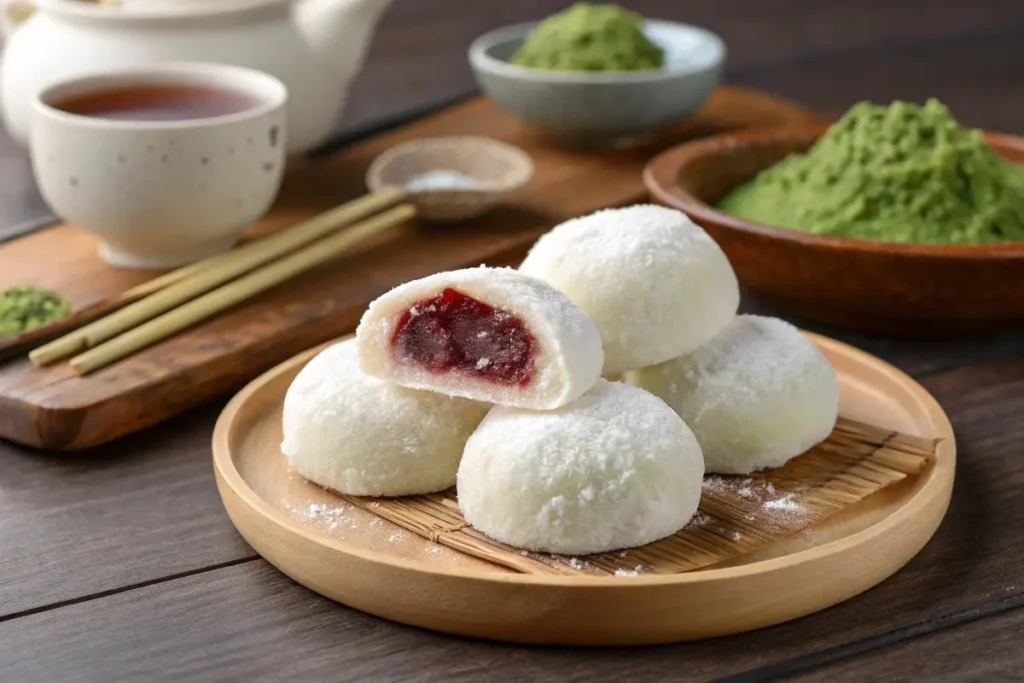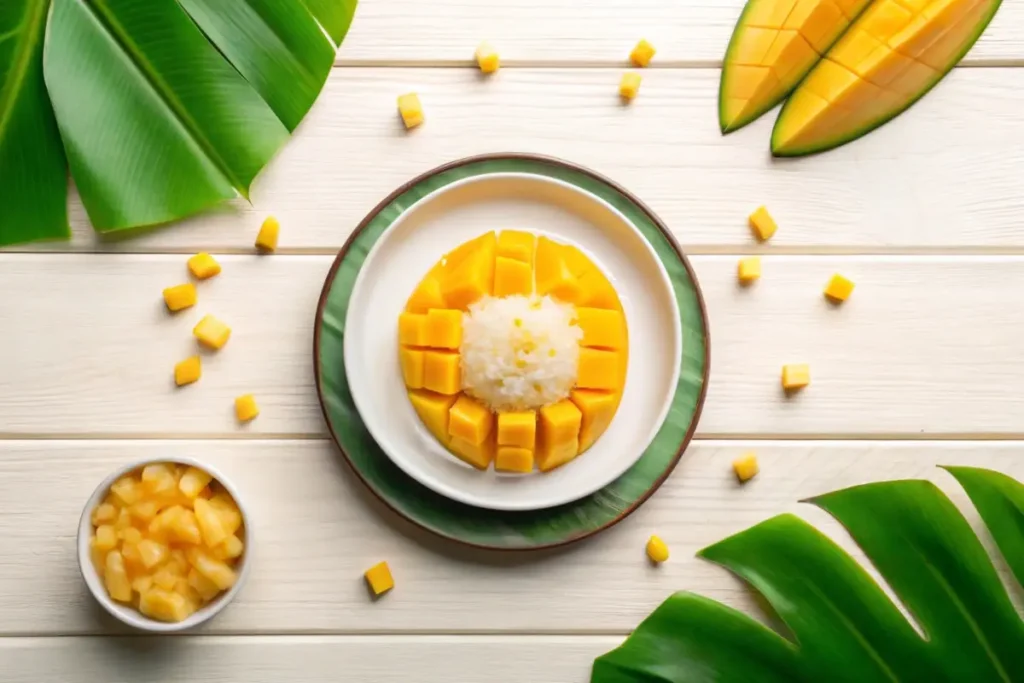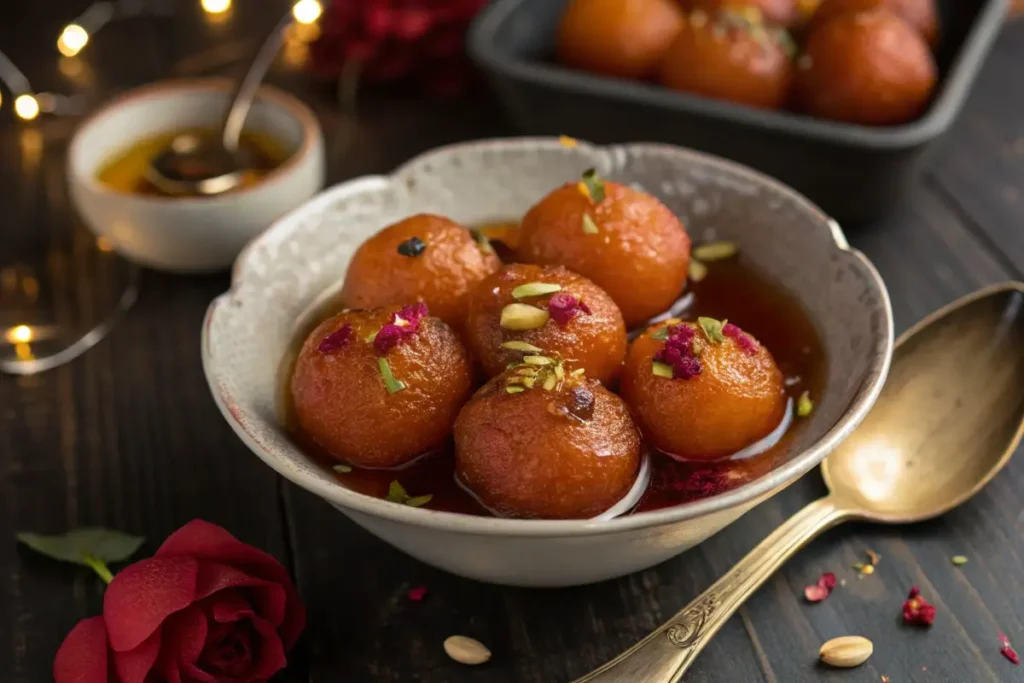When it comes to satisfying a sweet tooth, Asian desserts offer an incredible variety of flavors, textures, and cultural significance. From chewy mochi in Japan to golden-fried gulab jamun in India, each dessert tells a story of tradition, ingredients, and artistry. Whether you love coconut milk-based sweets, bean paste confections, or tropical fruit treats, there’s something for everyone in the world of Asian sweets.
In this guide, we’ll explore the most famous traditional Asian desserts, categorized by regions—East Asia, Southeast Asia, and South Asia—before diving into modern fusion creations. Along the way, we’ll highlight must-try treats, their unique ingredients, and how they’ve evolved over time. Let’s embark on this delicious journey through the world of Asian confections!
Introduction to Asian Desserts
Asia is home to an incredibly diverse range of desserts, each influenced by local traditions, seasonal ingredients, and cultural festivities. Unlike Western desserts, which often focus on rich dairy-based confections, many Asian sweets rely on rice, beans, coconut, and tropical fruits to create distinct flavors and textures. From light and chewy to crispy and deep-fried, these desserts offer a little bit of everything.
The Cultural Significance of Asian Sweets
In many Asian cultures, desserts are deeply tied to festivals, celebrations, and family traditions. For example, mochi is an essential part of Japanese New Year celebrations, while tangyuan symbolizes unity and happiness during the Chinese Lantern Festival. In India, sweets like barfi and jalebi are exchanged during Diwali as a symbol of prosperity and good luck.
Unlike Western cakes and pastries, many Asian desserts are not overly sweet. Instead, they focus on natural flavors, using ingredients like palm sugar, honey, or fruit syrups for sweetness.
Common Ingredients in Asian Desserts
What makes Asian sweets so unique? Their ingredients! Some of the most commonly used elements include:
- Glutinous rice – The base for many chewy and sticky desserts.
- Red bean paste – A staple in Chinese, Japanese, and Korean confections.
- Coconut milk – A key ingredient in many Southeast Asian sweets.
- Mung beans – Used in puddings and jellies.
- Palm sugar – A rich, caramel-like sweetener.
- Sesame seeds & peanuts – Often used for extra crunch and flavor.
These ingredients not only add distinct flavors but also bring nutritional value, making many Asian desserts a delicious yet wholesome indulgence.
This introduction sets the stage for an exciting exploration of Asian desserts. Next, we’ll dive into the delicious world of East Asian sweets, covering China, Japan, and Korea. Stay tuned!
East Asian Desserts
East Asia is home to some of the most well-known Asian desserts, featuring a mix of chewy, creamy, and crispy textures. With influences from China, Japan, and Korea, these treats are often made from glutinous rice, red bean paste, and light dairy components. Let’s take a closer look at some of the must-try desserts from this region.

Chinese Delicacies
Tangyuan: Glutinous Rice Balls in Sweet Syrup
As one of the most symbolic Chinese desserts, tangyuan holds a special place in the Lantern Festival celebrations. People enjoy these soft, chewy rice balls filled with black sesame paste, red bean paste, or crushed peanuts, which create a rich, nutty flavor. They serve tangyuan in warm, lightly sweetened syrup, symbolizing family unity and togetherness.
Wandouhuang: Pea Flour Cake
A lesser-known yet traditional Beijing snack, wandouhuang is made from yellow pea flour, honey, and rock sugar. This mildly sweet, jelly-like treat has a smooth texture and is often enjoyed chilled. Though simple, it remains a favorite during springtime celebrations.
Japanese Confections
Mochi: Chewy Rice Cakes
One of the most famous Asian desserts, mochi is a soft, chewy rice cake made from glutinous rice flour and water. Often dusted with cornstarch to prevent sticking, these little delights come in various flavors and fillings, such as red bean paste, ice cream, or matcha cream. Whether served fresh or frozen, mochi is a beloved Japanese treat.
Japanese Cheesecake: Light and Fluffy Delight
Unlike traditional Western cheesecakes, Japanese cheesecake is airy, soft, and mildly sweet. It uses a combination of cream cheese, eggs, and cake flour, resulting in a soufflé-like texture. This light dessert melts in your mouth and pairs perfectly with tea or coffee.
Korean Treats
Hotteok: Sweet Filled Pancakes
If you love street food, hotteok is a must-try! These Korean pancakes are filled with brown sugar, cinnamon, and crushed nuts, creating a warm, gooey center when fried. Crispy on the outside and soft inside, they’re especially popular during the colder months.
Bingsu: Shaved Ice with Sweet Toppings
A perfect summer treat, bingsu consists of finely shaved ice topped with sweetened condensed milk, red beans, fruit, or rice cakes. Modern versions even include matcha, Oreo, and coffee flavors, making it a highly customizable dessert.
Southeast Asian Desserts
Southeast Asia is known for its bold flavors, tropical ingredients, and vibrant colors. Coconut milk, pandan leaves, palm sugar, and sticky rice play a significant role in many of these beloved Asian desserts. Let’s explore some of the region’s most iconic sweets.

Thai Sweets
Mango Sticky Rice: A Tropical Favorite
One of the most famous Asian desserts, mango sticky rice combines sweet glutinous rice, coconut milk, and ripe mango slices. Topped with toasted mung beans for crunch, this simple yet flavorful dessert is a staple at Thai street markets and restaurants.
Khao Tom: Steamed Sticky Rice Packages
Sticky rice wrapped in banana leaves—that’s khao tom! This Thai delicacy comes with a variety of fillings, including sweet coconut, black beans, or banana slices. The steaming process infuses the rice with a subtle earthy aroma, making it both delicious and fragrant.
Vietnamese Delights
Chè: Sweet Dessert Soup
Chè is a broad term for Vietnamese dessert soups, which can include a mix of beans, jelly, fruit, and coconut milk. Some versions are served hot, while others are chilled with crushed ice. A popular variation, chè ba màu (three-color dessert), layers mung beans, red beans, and pandan jelly for a vibrant look and rich taste.
Bánh Flan: Vietnamese Caramel Custard
A French-influenced dessert, bánh flan is similar to crème caramel but with a Vietnamese twist. Made with eggs, condensed milk, and sugar, it has a smooth, silky texture and is often topped with a layer of dark caramel syrup.
Indonesian Confections
Cendol: Iced Coconut Milk Dessert
One of Southeast Asia’s most refreshing Asian desserts, cendol consists of green rice flour jelly, coconut milk, and palm sugar syrup. Served over crushed ice, it’s a perfect balance of sweet, creamy, and slightly chewy textures.
Klepon: Sweet Rice Cake Balls
Chewy, sweet, and bursting with flavor, klepon are Indonesian rice cake balls filled with molten palm sugar and rolled in shredded coconut. With every bite, the sugar filling oozes out, making it a delightful surprise.
Southeast Asia’s desserts are colorful, flavorful, and deeply rooted in tradition. Whether you prefer rich coconut-based treats or light, refreshing sweets, there’s no shortage of options to explore.
Up next, we’ll journey into the world of South Asian desserts, where flavors like saffron, cardamom, and rose water take center stage!
South Asian Desserts
South Asia boasts a rich tapestry of desserts that tantalize the taste buds with aromatic spices, dairy richness, and syrupy sweetness. From the bustling streets of India to the festive tables of Pakistan and Bangladesh, these Asian desserts are integral to celebrations and daily indulgences.

Indian Sweets
Gulab Jamun: Deep-Fried Milk Balls in Syrup
Gulab jamun stands as a quintessential Indian dessert, featuring deep-fried balls made from khoya (reduced milk) or milk powder. These golden spheres are soaked in a fragrant sugar syrup infused with cardamom, rose water, or saffron, resulting in a melt-in-the-mouth experience. Often garnished with chopped nuts, gulab jamun graces festivals, weddings, and special occasions across India.
Carrot Halwa: Sweet Carrot Pudding
Known locally as gajar ka halwa, this dessert is a winter favorite in North India. Grated carrots are slow-cooked with milk, sugar, and ghee until they meld into a rich, creamy pudding. Flavored with cardamom and adorned with nuts and raisins, carrot halwa offers warmth and comfort in every bite.
Pakistani Delicacies
Jalebi: Crispy Fried Sweet Spirals
Jalebi is a popular treat in Pakistan, known for its intricate, spiral shapes. Cooks prepare it by fermenting a batter of all-purpose flour and yogurt before piping it into hot oil. They fry the spirals until crisp, then soak them in saffron-infused sugar syrup, which gives them a glossy sheen and delightful sweetness. People often enjoy jalebi hot, pairing it with milk or rabri (thickened sweetened milk) for a richer taste.
Barfi: Milk-Based Fudge
Barfi encompasses a range of milk-based confections, with textures ranging from dense to slightly crumbly. Prepared by condensing milk and sugar, barfi can be flavored with various ingredients like pistachios, almonds, coconut, or mango. Cut into diamond or square shapes, these fudges are a staple during festivals and celebrations.
Bangladeshi Treats
Rasgulla: Spongy Cheese Balls in Syrup
Rasgulla, a beloved sweet from the Bengal region, features soft, spongy balls made from chhena (fresh cottage cheese) and semolina. Cooks boil these balls in light sugar syrup, allowing them to absorb the sweetness and develop a delicate texture. People cherish rasgulla for its lightness, often serving it during festive occasions.
Sandesh: Delicate Milk-Based Sweet
Another Bengali delight, sandesh showcases the art of kneading fresh chhena with sugar and flavorings like cardamom or saffron. Cooks shape the mixture into various forms and sometimes garnish it with pistachios or a touch of edible silver leaf. Its subtle sweetness and creamy texture make sandesh a true testament to the region’s rich confectionery tradition.
Fusion and Modern Takes on Asian Desserts
The global culinary landscape has witnessed a delightful fusion of traditional Asian desserts with contemporary flavors and techniques. Chefs and home cooks alike are experimenting, resulting in innovative creations that pay homage to their roots while appealing to modern palates.
Innovative Twists on Traditional Sweets
Chefs and home cooks are reimagining classic Asian desserts with new ingredients and presentations. For instance, they have introduced variations of traditional Indonesian klepon—glutinous rice balls filled with palm sugar—by substituting rice flour with yam or sweet potato. Some even replace the customary palm sugar filling with chocolate. Additionally, toppings like grated cheddar cheese add a savory contrast to the sweet base, creating a unique fusion of flavors.
Similarly, the Japanese mochi has undergone transformations, with fillings like Nutella or matcha-flavored cream, catering to diverse taste preferences. These adaptations maintain the chewy texture of mochi while introducing new flavor profiles.
Incorporating Asian Flavors into Western Desserts
For example, the rich, nutty essence of black sesame has been infused into classic ice cream bases, resulting in a unique dessert that blends familiar textures with distinctive and intriguing flavors.
Another notable creation is the mango pomelo sago cheesecake, which combines the creamy texture of Western cheesecake with the tropical flavors of the popular Hong Kong dessert. This fusion offers a refreshing twist, blending the tartness of cheesecake with the sweetness of mango and the slight bitterness of pomelo.
These innovative desserts not only showcase the versatility of Asian ingredients but also reflect a growing appreciation for cross-cultural culinary exploration. As the world becomes more interconnected, the fusion of traditional and modern, East and West, continues to enrich our gastronomic experiences.
For more delicious recipes, check out our dessert collection.
Stay tuned as we delve into frequently asked questions about Asian desserts in the next section!
FAQs
With such a vast variety of Asian desserts, it’s natural to have questions about their ingredients, flavors, and preparation methods. Below are some of the most commonly asked questions about these delightful sweets.
What are some popular Asian desserts?
There are countless Asian desserts, but some of the most famous include mochi (Japan), gulab jamun (India), mango sticky rice (Thailand), and bingsu (Korea). Each dessert has its own unique texture and flavor, making them special in their own way.
What ingredients are commonly used in Asian sweets?
Most Asian desserts rely on glutinous rice, coconut milk, red bean paste, palm sugar, mung beans, and fresh tropical fruits like mango and durian. These ingredients create distinctive textures and flavors that set them apart from Western confections.
Are Asian desserts typically very sweet?
It depends on the dessert! Many Asian sweets have a milder sweetness compared to Western cakes and pastries. Ingredients like red bean paste and coconut milk provide natural sweetness, while some desserts, like jalebi or gulab jamun, are more sugary due to syrup infusions.
Can I make these desserts at home?
Absolutely! Many Asian desserts are simple to prepare with the right ingredients. While some require special techniques, such as kneading mochi dough or deep-frying jalebi, others—like mango sticky rice or cendol—are easy to recreate in your kitchen.
Conclusion: A Sweet Journey Through Asian Desserts
Exploring Asian desserts is like embarking on a flavorful adventure. From the chewy mochi of Japan to the syrupy gulab jamun of India, these sweets showcase the diversity of Asian culinary traditions. Whether you’re savoring Vietnamese chè on a hot day or enjoying a warm bite of hotteok during winter, there’s always something special about these treats.
The beauty of Asian desserts lies in their use of simple, natural ingredients to create unforgettable flavors. Whether you prefer rice-based treats, coconut-infused delights, or syrupy confections, there’s an Asian sweet to satisfy every craving.
Now that you’ve discovered some of the most beloved Asian desserts, why not try making one at home? For more inspiration, check out our collection of dessert recipes and start your sweet journey today!

